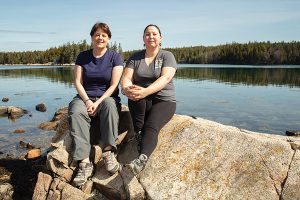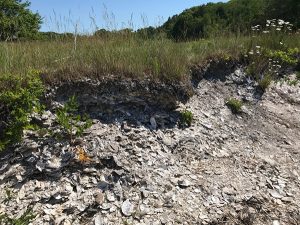Reconnecting Wabanaki Communities to Coastal History

By Nate Poole
An Indigenous archaeologist at UMaine is reconnecting Wabanaki communities to coastal heritage sites facing the threat of climate change
Maine’s coastline is well known for its historic forts, villages, and lighthouses. However, some of the state’s most overlooked landmarks date well before colonial contact, and the wealth of knowledge that they contain is at risk of being swept away by rising sea levels.
Maine’s coast is dotted with over 2,000 shell heaps, sites where Wabanaki ancestors would gather to harvest and eat shellfish, producing deposits of shells ranging in size from small piles to 30-foot-deep mounds. These collections of exceptionally well-preserved materials can help scientists reconstruct a record of past lifeways and environments. For hundreds of years, scientists and industries have extracted a wealth of materials and history from some shell heaps without consultation or collaboration with those whose ancestors created them. As sea level rise accelerates, these losses are compounded by increasing erosion. Dr. Bonnie Newsom is one of the scholars urgently seeking to reconnect Wabanaki people to shell heaps before they disappear forever.
“It’s just a matter of giving voice to those folks whose heritage we’re working on and making sure that there’s space for them to have a say in how these places are interpreted and managed,” Newsom said.
Newsom is an archeologist and an assistant professor with the University of Maine’s Department of Anthropology; a citizen of the Penobscot Nation, she has also served as the nation’s Tribal Historic Preservation Officer and the Assistant Director of UMaine’s Wabanaki Center. For several years, Newsom has studied Maine’s shell heaps with Dr. Alice Kelley, an associate professor with UMaine’s Climate Change Institute. Together they co-founded the Maine Midden Minders, a citizen science effort to monitor the erosion of the state’s shell heaps and efficiently determine where researchers should direct their efforts to gather data and culturally significant artifacts. The effort was supported in part by the Senator George J. Mitchell Center for Sustainability Solutions.
Despite their noteworthy archeological efforts dedicated to shell heap research, the sites’ value is not regarded as common knowledge among many Wabanaki people due to land displacement and alienation, among other factors. To address this, Newsom, Kelley, and UMaine graduate student and Passamaquoddy-Penobscot citizen Natalie Dana Lolar organized a series of webinars focused on encouraging Wabanaki engagement in shell heap research. The project, a collaboration of tribal representatives, the Abbe Museum, Acadia National Park, and Schoodic Institute, was supported by grant funding from the Mitchell Center. For the webinars, Newsom and her partners produced three short films focused on shell heaps. The films address the value of shell heaps, the efforts underway to protect them, and the future of co-managing heritage spaces of archeological significance.
Humanizing Research, Elevating Ancestors

A thirty-foot deep shell heap, dubbed the Whaleback Shell Midden for its shape, once occupied the east side of the upper Damariscotta River. However, much of the material was extracted from the site in the late nineteenth century to process the oyster shells into chicken feed supplement, according to the Maine Bureau of Parks and Lands. Prior to that mining, the Peabody Museum at Harvard University purchased the rights to the artifacts found there. Now, the Whaleback is a state historic site managed by the bureau and little remains of the heap that once stretched 400 feet back from the riverbank.
“People have built careers on Indigenous heritage without ever consulting with Indigenous peoples, and that has occurred across north America,” Newsom said. “That’s something that needs to be corrected.”
The history of archeology is marred by extractive and exclusionary practices, and Maine’s shell heaps are just another example of how tribes have been distanced from their own history and culture. One of Newsom’s priorities as an Indigenous archeologist is not only making this information available but translating it in such a way that it is accessible for Wabanaki community members. Ultimately, Newsom and her colleagues help ensure that tribal members can actively shape the management and decision-making regarding their own heritage resources.
“If Indigenous peoples were at the table back then, perhaps the Whaleback would still be intact,” Newsom suggested.
In fact, if tribes had been involved in the management of the Whaleback, it may not have been named a “midden”. In one of the short films, Newsom argues that the term “midden” is a misnomer, as it implies that a shell heap is simply a pile of rubbish. To the contrary, the heaps could have served as navigation aids, boundary markers, or some other utility. Throughout her career, Newsom has sought out ways to paint a complex, human portrait of Indigenous history that is so often missing from archeological research. When she communicates her findings, she refers to “research subjects” as ancestors that she has a relationship to and a respect for, and shell heaps represent a space to reconnect with those ancestors and stand where they stood.
Newsom offers the kind of expert voice that Isaac St. John wishes he had access to as an undergraduate student at Bates College. St. John is the Tribal Historic Preservation Officer for the Houlton Band of Maliseet Indians and has worked closely with Newsom on projects involving shell heaps. As an anthropology student, he was often left to piece together information about the Maliseet people from those who had interpreted it with a distinctly western perspective, and it inspired him to continue to pursue his own research.
“I learned about my culture through second-hand stories and ethnographies written by academics from outside of the state. I had to sort through that to figure out what was real and what was an actual practice that I could recognize in the Maliseet community,” he said. “I do not want future Maliseet people to have to sort through secondary sources rather than stories from their own people.”
Revealing Muted Histories
The process of organizing the webinars was not without its hiccups. Developing a coherent message, producing the films, and organizing the webinars resulted in a tight timetable for Newsom and her colleagues. After plans fell through with a local partner that was going to host the events, the Mitchell Center quickly emerged as a supportive partner for the webinars. While the logistical process may have felt haphazard, Newsom said that the conversation with attendees was still rich. Most discussions centered on ownership, stewardship, and access to the shell heaps for Wabanaki people, but a common sentiment was a desire to make the films public so that educators in Indigenous and non-Indigenous schools could use them.
“I think we have lots of lessons that we can learn from the people [who] lived before us. They were sustainable for 12,000 years,” she said. “I think it will be good for humanity if we can just get [the films] in front of people in K-12 [classrooms] and beyond.”
Kelley hopes that these kinds of efforts not only contribute to awareness, but active engagement in preservation efforts across Maine.
“I would like to see the Midden Minders project, with these webinars as part of our educational material, develop into a coastwide effort,” Kelley said. “[Our goal is] to bring all of Maine’s people together to respect and document the Indigenous cultural heritage that is an important part of the state’s history.”
Newsom hopes that the films and other outreach efforts can inspire another generation of Indigenous archeologists like herself, Dana Lolar, and St. John, who are eager to re-examine extracted collections through an Indigenous lens and share those muted histories with the tribes.
“That’s one of my dream goals in my position here at the University of Maine, to inspire other Indigenous young people to take an interest and take control of their heritage and the interpretation of that heritage,” she said.
